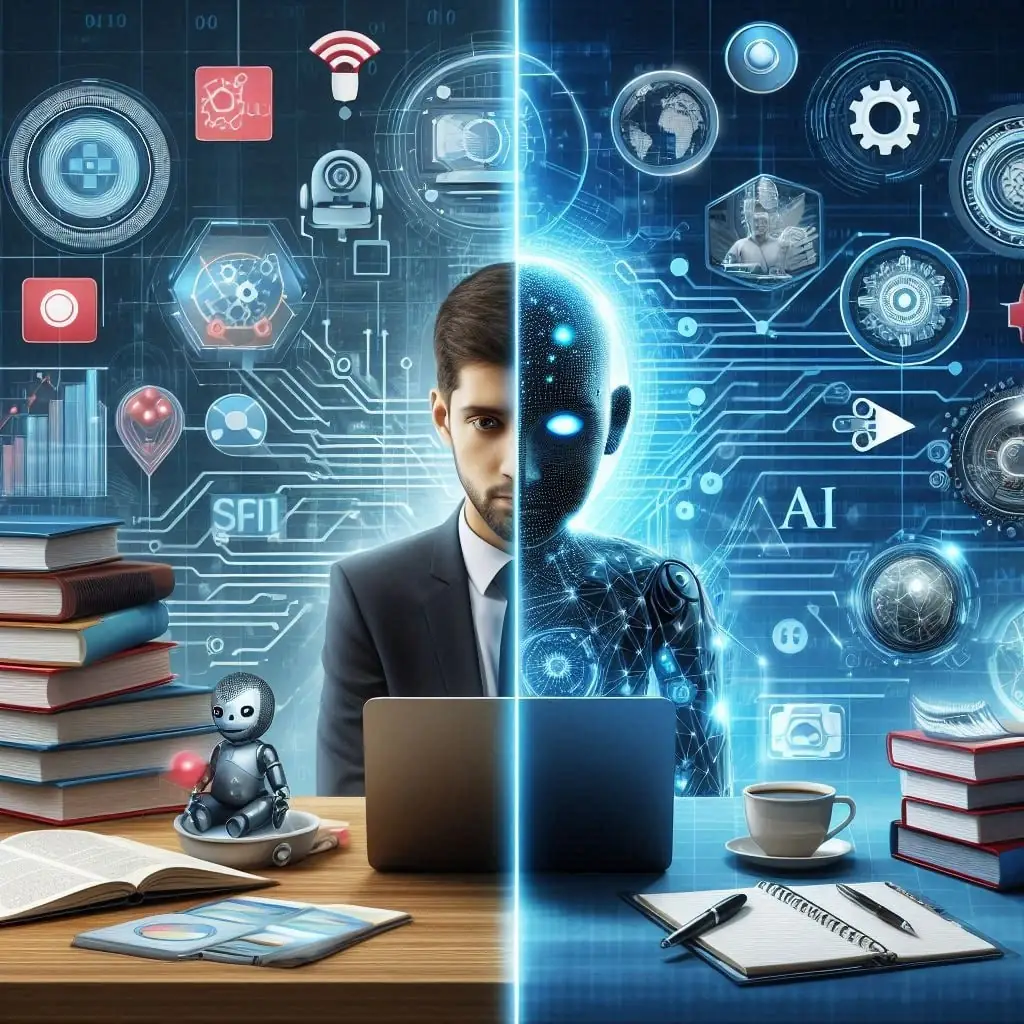Today’s employees are drowning in a sea of information. Countless documents, applications, internal chats, and more make it harder than ever to find the knowledge and answers they need to perform their tasks. AI helps improve the use of knowledge in customer service, ensuring team members can easily access the information they need. It uses advanced tools to collect, govern, and tag content and documents so people can quickly find the answers they seek.
What is Knowledge AI
An artificial intelligence system specifically designed to manage, process, and leverage knowledge, Knowledge AI goes beyond handling data or information. It also understands, interprets, and generates insights from complex sets of information, often mimicking human reasoning.
Key features of knowledge AI include:
- Contextual Understanding. Because the technology understands the context around data, it provides more accurate and relevant responses or actions.
- Learning and Adapting. The system learns from interactions and feedback, continuously improving its knowledge base and the relevance of its output.
- Decision-Making. Insights derived from a broad and deep analysis of available knowledge assist in more informed decision-making.
- Semantic Processing. The technology understands the meanings and relationships between different pieces of information. This allows it to handle complex queries and provide contextually appropriate explanations or solutions.
- Integration of Multiple Knowledge Sources. Knowledge AI combines and processes information from different sources, including structured and unstructured data, to provide a complete understanding. This is particularly helpful in customer service when agents need to access and process an organization’s entire knowledge base. Healthcare providers can use it for diagnosis and treatment recommendations based on medical literature and patient data. It also assists in business intelligence, offering strategic insights by analyzing market trends and internal data.
Key Components of Knowledge AI
Knowledge AI uses Large Language Models (LLMs) and Generative AI (Gen-AI) to analyze and comprehend text-based information. It then generates responses tailored to the specific questions or queries users pose. Crucial system components include:
- Knowledge Base. The central repository where all information is stored, including contextual rules and relationships between data points, it is often structured in a way that mirrors human intellect.
- Natural Language Processing. NLP enables AI to understand and generate human language. It is vital for interpreting queries, extracting textual information, and providing answers humans can understand.
- Machine Learning and Deep Learning. AI uses these technologies to learn from data, identify patterns, and make decisions with minimal human intervention. It uses them to continuously improve response accuracy and knowledge retrieval efficiency.
- Semantic Analysis. By accurately interpreting human language, AI systems can perform more sophisticated tasks that require understanding not only the written word but also user intent and context.
- Inference Engines. These systems apply logic and reasoning to knowledge bases to derive new information or decisions from existing data. They are essential for dynamic problem-solving and decision-making.
- Cognitive Computing. These systems simulate human thought processes in a computerized model. They use self-learning algorithms, including data mining and pattern recognition, to mimic how the human brain works.
- Data Integration Tools. These tools help assimilate and manage data from diverse sources, ensuring an AI-powered system has the most up-to-date and comprehensive information.
- User Interface. This component makes interaction with the AI system user-friendly, whether through textual interfaces, voice commands, or other interactive modes.
Knowledge AI leverages these elements to perform complex tasks such as automating customer support, providing personalized recommendations, and enhancing decision-making processes.
What is Knowledge Management
Knowledge management (KM) is the creation, sharing, using, and managing of an organization’s knowledge and information. It involves:
- Capturing and documenting knowledge.
- Organizing and storing information.
- Distributing knowledge throughout an organization.
- Making knowledge creation and innovation easier.
- Applying knowledge to improve processes and decision-making.
KM’s primary goal is to use collective knowledge to enhance organizational performance, competitiveness, and innovation through strategies like creating knowledge bases, supporting workforce collaboration, and setting up systems to share best practices.
Key Components of Knowledge Management
KM’s core building blocks generally include:
- People: The individuals who create, share, and use knowledge within an organization.
- Processes: The methods and procedures for capturing, storing, and disseminating knowledge.
- Technology: Knowledge management tools and systems that support related activities.
- Culture: An organizational environment that encourages knowledge sharing and collaboration.
- Content: The actual information and knowledge being managed.
- Strategy: The plan for implementing and maintaining knowledge management initiatives.
- Governance: Policies and guidelines for managing knowledge assets.
- Measurement: Methods for assessing the effectiveness of knowledge management initiatives.
These components are vastly interconnected and mutually reinforcing. For instance, people use processes and technology to create and share content, and organizational culture influences how willingly people share knowledge. Governance structures guide these interactions, and knowledge management strategy directs the entire approach, influencing which technologies are adopted and which processes are implemented. Measurement provides feedback on the effectiveness of all other components, allowing for continuous improvement.
Put another way, even the most advanced technology won’t be effective if people aren’t motivated to use it or if there aren’t clear processes for its use. Similarly, a solid knowledge-sharing culture can be hampered by poor technology or unclear governance. A good KM strategy considers all components, creating a cohesive system where each supports the others. This interconnectedness means successful knowledge management requires a holistic approach, addressing all elements in a coordinated manner.
Main Differences Between Knowledge AI and Knowledge Management
KM and Knowledge AI are related concepts but have distinct focuses and methodologies.
- Knowledge management is a broader organizational practice that has been around for decades.
- Knowledge AI is a more recent technological approach that leverages AI to enhance knowledge-related processes.
Key differences between the two include:
- Scope. KM encompasses a wide range of organizational practices, while Knowledge AI focuses specifically on AI-powered solutions.
- Human involvement. KM heavily relies on human expertise and interaction. Knowledge AI automates and amplifies human cognitive processes.
- Technology. Traditional KM often uses various technologies. Knowledge AI specifically employs advanced techniques like machine learning and NLP.
- Data handling. KM often deals with structured and semi-structured data, while knowledge AI can handle and derive insights from unstructured data more effectively.
- Scalability. Knowledge AI systems process and analyze vast amounts of data much faster than traditional KM approaches.
- Adaptability. Knowledge AI systems continuously learn and improve their performance. Traditional knowledge management systems might require manual updates.
- Implementation. KM is typically implemented as an organization-wide strategy. Knowledge AI can be applied to specific tasks or departments.
Despite these differences, Knowledge AI and KM are not mutually exclusive. In fact, many organizations are integrating AI technologies into their existing KM frameworks to create more powerful and efficient systems. This blending of technologies allows them to leverage each approach’s strengths, combining human expertise with AI capabilities to enhance overall organizational knowledge and decision-making processes.
Applications and Benefits
The importance of Knowledge AI in enhancing organizational efficiency and decision-making cannot be overstated. Here’s how KM and Knowledge AI can be applied and the benefits they bring to the table:
Applications and Benefits of Knowledge AI
Knowledge AI can be used in areas requiring advanced data interpretation, automated reasoning, and complex dataset learning. For instance, Knowledge AI in customer service can provide real-time, context-aware responses to customer inquiries, drastically reducing response times and improving customer satisfaction. In the healthcare sector, it can analyze vast amounts of medical data to assist in diagnosing diseases and recommending treatments, personalizing and enhancing the accuracy of medical care. Knowledge AI’s primary benefit is its ability to handle and make sense of large volumes of data at a scale humans cannot.
Applications and Benefits of Knowledge Management
By organizing knowledge creation, capture, and sharing, KM facilitates continuous organizational learning and knowledge reuse. For example, many businesses use KM to improve new employee onboarding. Knowledge repositories enable quick problem-solving and innovation, giving employees easy access to historical data, project reports, and expert insights. KM’s benefits include improved productivity, enhanced decision-making, and a competitive edge through the strategic use of collective intellectual resources.
Synergistic Benefits of Integrating Knowledge AI with KM
Integrating Knowledge AI with KM systems is transforming organizational knowledge landscapes. Knowledge AI extends KM’s capabilities, automating tacit and explicit knowledge extraction and structuring while enriching knowledge bases. For instance, AI tools are used to transcribe and analyze video and audio from meetings, capturing insights that might otherwise be lost. Knowledge AI can also provide personalized employee learning paths, suggesting relevant documents and learning materials stored in KM systems based on individual learning behaviors and needs.
Ensuring information is up-to-date, relevant, and easy to find is an ongoing desire for every organization that relies on data for support and business operations. KMS Lighthouse provides teams with the AI-powered knowledge management system they need to give customers AI-speed service. A recent Lastminute.com case study shows a reduction in average handling times by 76% and a decrease in customer feedback management from 22 to four days. There’s no better proof of the transformative impact of integrating AI with KM and how doing so will revolutionize how your organization manages, uses, and benefits from its knowledge resources.



